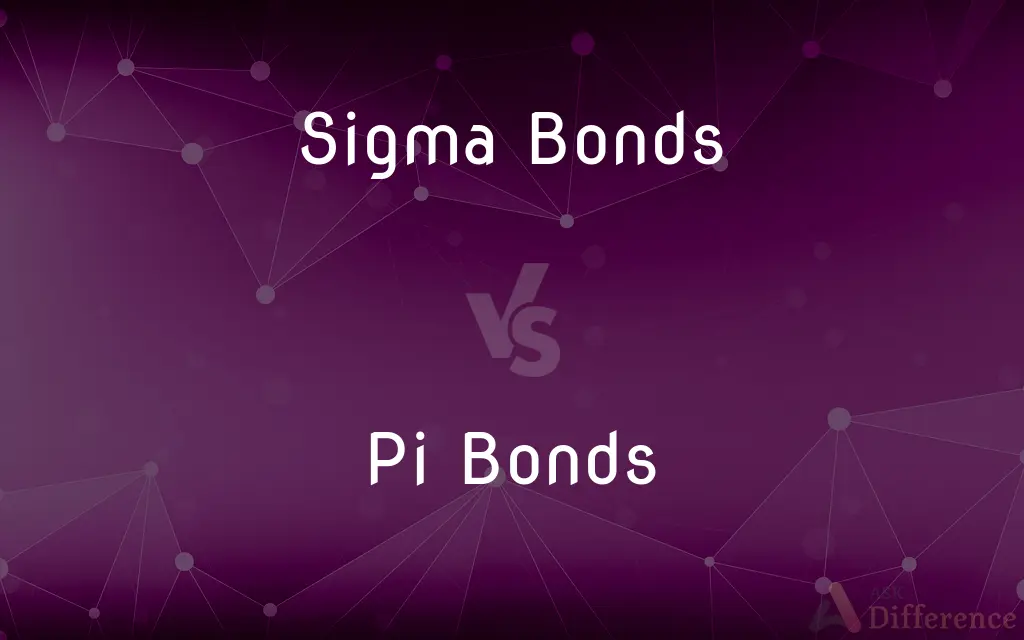Sigma Bonds vs. Pi Bonds — What's the Difference?
By Tayyaba Rehman & Fiza Rafique — Published on February 4, 2024
Sigma bonds involve head-on orbital overlap, creating strong, single bonds; pi bonds involve side-by-side orbital overlap, adding double or triple bond strength.

Difference Between Sigma Bonds and Pi Bonds
Table of Contents
ADVERTISEMENT
Key Differences
Sigma bonds (σ bonds) are the most basic type of covalent bond, formed by the head-on overlapping between atomic orbitals. These bonds create a direct pathway of electron density between the nuclei of two atoms, resulting in a strong, stable bond. Sigma bonds are the first bonds to form between atoms, establishing a single bond framework in molecules.
Pi bonds (π bonds), in contrast, arise from the lateral or side-by-side overlap of p orbitals across two adjacent atoms. They do not form without the presence of a sigma bond and typically add to the bond order of molecules, as seen in double or triple bonds. Pi bonds are less strong than sigma bonds due to their diffuse electron density.
The distinction between sigma and pi bonds is crucial for understanding molecular geometry and bond strength. Sigma bonds allow for free rotation of bonded atoms around the bond axis, contributing to the three-dimensional shape of molecules. Pi bonds, however, restrict this rotation due to the parallel alignment of p orbitals, which is essential for the rigidity in structures of molecules with multiple bonds.
In terms of electron distribution, sigma bonds have a symmetric distribution along the bond axis, contributing to their strength and stability. Pi bonds, with their electron density concentrated above and below the plane of the atoms, are more exposed to external reactions, making them less stable but crucial for chemical reactivity.
Overall, sigma and pi bonds are fundamental to the structural integrity and reactivity of molecules. Sigma bonds form the backbone of molecular structures, while pi bonds enhance the complexity and diversity of chemical bonding, playing a key role in the properties of organic and inorganic substances.
ADVERTISEMENT
Comparison Chart
Type of Overlap
Head-on overlap of orbitals
Side-by-side overlap of orbitals
Bond Strength
Stronger due to direct overlap
Weaker than sigma bonds due to indirect overlap
Bond Order
Single bonds
Double or triple bonds (in addition to a sigma bond)
Electron Density
Symmetrically distributed along the bond axis
Concentrated above and below the bond plane
Rotation around Bond Axis
Free rotation possible
Restricted rotation due to electron cloud distribution
Compare with Definitions
Sigma Bonds
Sigma bonds are the strongest type of covalent bond due to head-on orbital overlap.
The C-C sigma bond in ethane allows for free rotation.
Pi Bonds
In pi bonds, electron density is concentrated above and below the bond plane.
The pi bond in benzene contributes to its aromatic stability.
Sigma Bonds
Every single bond in molecules includes a sigma bond.
The O-H sigma bonds in water are essential for its liquid state.
Pi Bonds
Pi bonds are always accompanied by a sigma bond in double and triple bonds.
The C=C bond in ethylene consists of one sigma and one pi bond.
Sigma Bonds
Sigma bonds are the first bonds to form during chemical bonding.
The formation of a sigma bond between two nitrogen atoms initiates N2 formation.
Pi Bonds
A pi bond is a type of covalent bond formed by the lateral overlap of p orbitals.
The double bond in O2 includes a pi bond.
Sigma Bonds
A sigma bond is a single covalent bond formed by the direct overlap of atomic orbitals.
The H-H bond in H2 is a sigma bond.
Pi Bonds
Pi bonds are weaker than sigma bonds due to their side-by-side orbital overlap.
The pi bond in ethene contributes to its reactivity.
Sigma Bonds
In sigma bonds, electron density is symmetrically distributed along the bond axis.
Sigma bonds in methane contribute to its tetrahedral shape.
Pi Bonds
Pi bonds restrict the rotation of bonded atoms, affecting molecular geometry.
The lack of rotation around the pi bond in butadiene keeps it planar.
Common Curiosities
Do sigma bonds allow for molecular rotation?
Yes, sigma bonds permit free rotation of bonded atoms, which is crucial for molecular flexibility.
Can a molecule have both sigma and pi bonds?
Yes, molecules with double or triple bonds have both sigma and pi bonds; the sigma bond forms first, followed by one or more pi bonds.
How do sigma and pi bonds affect chemical reactivity?
Sigma bonds provide stability, while pi bonds, being more exposed, play a significant role in chemical reactions and reactivity.
Can a single bond be a pi bond?
No, single bonds are always sigma bonds; pi bonds only contribute to multiple bonds (double or triple bonds).
What is a sigma bond?
A sigma bond is the primary bond formed by the direct overlap of atomic orbitals, creating a strong and stable connection between two atoms.
What is a pi bond?
A pi bond is a type of covalent bond that forms from the side-by-side overlap of p orbitals, contributing to double and triple bonds in molecules.
Why are sigma bonds stronger than pi bonds?
Sigma bonds involve direct orbital overlap, leading to a stronger bond compared to the indirect, side-by-side overlap in pi bonds.
Do all molecules have pi bonds?
No, only molecules with double or triple bonds contain pi bonds; single-bonded molecules only have sigma bonds.
Can pi bonds exist without sigma bonds?
No, pi bonds cannot exist without an accompanying sigma bond; they always occur together in multiple bonds.
How does the overlap differ in sigma and pi bonds?
In sigma bonds, orbitals overlap head-on, whereas in pi bonds, p orbitals overlap laterally.
Are pi bonds responsible for molecular shapes?
Yes, the presence of pi bonds can restrict rotation and influence the overall shape and rigidity of a molecule.
How do sigma and pi bonds contribute to bonding in organic molecules?
In organic molecules, sigma bonds form the backbone structure, while pi bonds add to the complexity and reactivity of compounds.
Are pi bonds involved in conjugation and resonance?
Yes, pi bonds are key to conjugation and resonance phenomena, contributing to the stability and color of certain organic compounds.
What role do sigma bonds play in molecular geometry?
Sigma bonds determine the basic framework and angles in molecular structures, influencing the three-dimensional shape.
How do sigma and pi bonds affect physical properties?
Sigma bonds influence boiling and melting points through molecular mass and structure, while pi bonds can affect color, reactivity, and more.
Share Your Discovery

Previous Comparison
SUV vs. XUV
Next Comparison
Position vs. DesignationAuthor Spotlight
Written by
Tayyaba RehmanTayyaba Rehman is a distinguished writer, currently serving as a primary contributor to askdifference.com. As a researcher in semantics and etymology, Tayyaba's passion for the complexity of languages and their distinctions has found a perfect home on the platform. Tayyaba delves into the intricacies of language, distinguishing between commonly confused words and phrases, thereby providing clarity for readers worldwide.
Co-written by
Fiza RafiqueFiza Rafique is a skilled content writer at AskDifference.com, where she meticulously refines and enhances written pieces. Drawing from her vast editorial expertise, Fiza ensures clarity, accuracy, and precision in every article. Passionate about language, she continually seeks to elevate the quality of content for readers worldwide.
















































